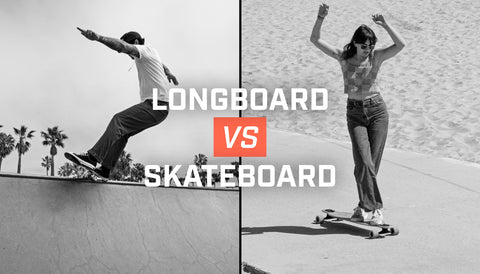The age old question... On the surface skateboarding and longboarding seem pretty similar. They both require you to manually push a deck that rolls on 4 wheels. They both require the same components. You can even do tricks on your longboard... So what exactly is the difference?
The 10 second answer:Skateboards are shorter, at around 31” (78 cm) long, with an angled nose and tail on either end. These are designed for tricks and hitting the skatepark.
Longboards are... surprise, surprise, longer! They are primarily used for cruising and transportation.
Skateboard decks are all roughly the same shape, commonly referred to as shortboards, standard skateboards or popsicle decks. They feature similarly designed trucks and small, hard wheels.
Longboards, on the other hand, come in a HUGE variety of shapes and sizes, with different options for trucks and wheels. They don’t even have to be that long. The term mostly refers to the transportation style of riding.
Skateboarding and longboarding may seem similar to new riders, but they actually have very different subcultures. Let’s get into the differences between skateboards vs longboards.
Beginners Q: What kind of skating are you looking to do?
The simplest way to look at this is by answering the following question: What kind of riding do you want to do? This will guide your choice as to which type of skateboard you should purchase.
If you’re looking to do tricks, you’ll want a skateboard. The upturned tail and nose design make doing tricks much easier and enable more creativity.
If you’re looking to cruise, carve and go fast, you’ll want a longboard. They are built for this exact purpose.
| Skateboards | Longboards | |
| Decks | lightweight ‘popsicle’ shape with upturned nose and tail for tricks | Longer, heavier board, designed primarily for cruising, carving and commuting |
| Wheels | Harder wheels (90a - 100a) for durability | Softer wheels (78a - 89a) for smooth riding over all surfaces |
| Trucks | Usually cast for high strength and durability for stalls & grinds | Can be traditional or reverse kingpin. Designed to carve and cruiser, similar to a surfboard or snowboard |
| Main Differences | Designed primarily for tricks, grinds and street skating | Designed for maximum maneuverability and a comfortable riding experience over long distances |
NOW, having outlined these general specs, we should note these are not hard and fast rules when it comes to skateboards. You can, indeed, make your skateboard into a cruiser board or do a kickflip on your longboard, it’s just the setups are engineered for different main purposes. It is, therefore, easier to land a kickflip on a skateboard and cruise on your longboard, because they have been designed for the ground up for exactly this.
If you are wanting to skate both styles but don’t wish to buy two boards, there is one sub-type that we should mention: the mini cruiser. These boards are hybrid skateboards, of sorts. They are smaller boards (around 30in) that allow you to cruise around like you would on a longboard but have an angled kicktail to allow for tricks like a traditional skateboard. They are a good blend of both types of boards if you aren’t going to be solely focusing on one style of riding. Check out our Fireball Mini Cruiser series or head to our Types of Longboard beginners guide to learn more.
Sound too good to be true? Of course there are limitations and they aren’t going to do EVERYTHING a longboard can do and EVERYTHING a skateboard can do. It’s a compromise.
From here out, we will get a little more in depth with the differences in components.

Component Comparison: Decks
This is the #1 most obvious difference between skateboards and longboards.
Skateboard decks tend to come around 28-32 inches in length and range from 7-10" inches in width. The wheelbase is usually 14-15 inches.
Skateboard decks have two angled lips on either end, referred to as the nose (front) and tail (back). These are designed to make it easier to pop and flick your foot for different tricks.
In terms of deck shape, there are some variety nowadays, but traditionally they are shaped like a popsicle, hence the terms ‘popsicle deck’
Skateboard decks are typically constructed of 7-ply maple wood. However, as we move toward the future of skateboarding, there are many brands improving construction with maple/fiberglass hybrids. These are a lot stronger but come at a premium. For example, Powell Flight Decks are x2 stronger than traditional 7-ply maple but will cost you around 40% more.
Longboards are longer and wider than skateboard decks. They run anywhere from around 33-60 inches long and 8.5-10 inches wide, with many different wheelbase options, giving you more customizability for your specific ride style. Longboards also come in many different shapes. Some of the most common longboard shapes are the dropped deck which provides a lower center of gravity, classic pintail cruisers, top mount, and drop through, but there are many more.
In addition to shapes, longboard decks are often made out of different materials, such as bamboo, fiberglass, carbon fiber, maple, cork, and composites. The longboard community in general is much more interested in the technical details and making small tweaks/improvements to their setups, hence the wide variety of styles and materials.
In terms of the shape, a longboard doesn't have the lip that a skateboard does, BUT you can still do tricks on them. This type of riding is commonly known as Freestyle.
To learn more about the variety of shapes, check out our types of skateboard guide
| Longboard Decks | Skateboard Decks | |
| Length | 33" - 60 " | 28" - 32" |
| Width | 8.5" - 10" | 7" - 10" |
| Shape | Many Shapes | Popsicle Shape |
| Construction | Maple, Bamboo, Fiberglass, Carbon Fibre, Cork or Composite | Maple or Fiberglass |
Component Comparison: Trucks
Skateboard trucks are narrower, smaller, and lighter. They are perfect for tricks and grinds. They are known as Traditional Kingpin (TKP) trucks.
Longboard trucks are wider and heavier, designed mostly for turns and carving. A lot of modern longboards use Reverse Kingpin (RKP) Trucks. This truck design allows for a higher turn per degree of lean, making it perfect for carving.

There is a lot more to learn about skateboard trucks. Continue your reading about RKP and TKP trucks here.
| Longboard Trucks | Skateboard Trucks | |
| Designed for | Turns / Carving | Tricks & grinds |
| Weight | Heavier | Lighter |
| Kingpin | Reverse Kingpin (RKP) | Traditional Kingpin (TKP) |
| Material | Cast or CNC | Cast |
Component Comparison: Wheels
Smaller wheels with a harder durometer (duro) are used for most skateboards. These are lighter and harder, enabling them to accelerate quickly and smoothly in the skatepark. Because they are harder, they also slide much easier, helping eliminate the wheels locking up when hitting the coping or grind rail.
Skateboard wheels come in only a few main shapes. These mostly have a much bigger radius on the lips, allowing room for error when landing tricks, unlike longboard wheels that tend to be more grippy and get hung up easier.

Larger wheels are used on most longboards. They also tend to be softer wheels, making them ideal for cruising and transportation as they glide straight over cracks and rocks in the roads. Longboard wheels cruise around easily and carry high speed for longer. If you are looking to powerslide with your wheels, look for a durometer around 81a with a pre-ground surface for sliding right out the box. Our recommendation, naturally, is our 60mm Tinder Wheel, which comes SlidePreppedTM for this exact purpose.
| Longboard Wheels | Skateboard Wheels | |
| Size | 60mm - 85mm | 50mm - 56mm |
| Durometer | 75a - 90a | 90a - 100a |
| Grip | More | Little |
| Material | Urethane Outer, Fiberglass core | Urethane |
Component Comparison: Bearings
One thing that is consistent across both skateboard and longboards are the bearings. There are two main styles: Built-in style bearings and standard bearings.
Built-in bearings, like our Dragon BUILT Bearings, have an extended inner race, eliminating the need for separate bearing spacers. They are usually marketed toward the longboard community, however they will work just as well in traditional skateboard wheels too.
Standard bearings, like our Dragon RACE Bearings, are the standard shape of skateboard bearing you might be familiar with. The only difference is that these do not have built-in spacers, so you’d have to buy spacers separately (I mean, you don’t have to, but we recommend it in order to improve bearing performance and life).
Bearings are the same for skateboards and longboards.

Component Comparison: Griptape
One other notable component to mention is the griptape. For regular skaters, you’ll mostly find Jessup or MOB grip on their deck, no matter if they are shredding pools or hitting the street.
For Longboarders though, the grip choice is a little more varied. Lower grit grip tape (corser griptape) gives extra grip on the board for downhill / freeride skating, wheras a higher grit grip tape (finer grip) would be used on a longboard for cruising or dancing. Again, personally preference comes into play significantly here.
Our friends at Stoked Ride Shop did a whole Ultimate Guide to Grip Tape. Check it out for more on picking your grip.
How much to spend on your board?
Longboard Prices:
A longboard is typically more expensive than a regular skateboard. The deck is larger, you have bigger wheels, wider trucks... you get the point. More materials = more cost.
Depending on exactly what type of longboard you’re looking for, these can cost anywhere from $100 to $500 for a complete setups. You can get some cheaply made longboards off Amazon or Walmart for less than $100, BUT you will find issues with the quality of the components after a few sessions. Great if you are not 100% certain you’ll love longboarding, but not great if you are wanting to get into the sport properly. You won’t get the best experience and may even be put off by your poorly performing longboard, thinking the sport is not for you, when really it’s just the sub-par board. So, yeah, avoid this.
We recommend spending about $150-$220 for a new longboard. If you’re spending below the $150 range, you’re either getting a board on discount (check here to see if our partners at Stoked Ride Shop have any on sale) or a board that will not have quality parts and not last very long. Most real skate companies have comprehensive guarantees, like our lifetime Beast Guarantee. If in doubt, look for a solid guarantee that gives you peace of mind.

Skateboard Prices:
Skateboards generally are less expensive than longboards as they use less material. A skateboard can cost anywhere from $25 - $200 depending on the quality of board you chose and whether you build it yourself or buy a pre-built complete.
Similarly to the longboard rule, above, if you find a fully built board for less than $75, it’ll likely have cheap components that wont last.
We would recommend looking to spend $80 to $140 for a full complete with decent parts. If you are looking for just a deck, $40 (quality blank deck) to $60 (graphic deck) is about right.
The difference between a $20 Amazon deck and a $40 quality blank deck, is that the $20 deck will be China-made, likely not fully Canadian Maple (they sandwich birch wood or ‘Russian Maple’ in-between top layers of Canadian Maple) and offer a dull pop, making it much harder to do ollies and tricks. Conversely, the $40 deck should be made in Mexico (arguably the mecca of deck production), with full Canadian Maple wood and, likely, epoxy resin, resulting in more pop and a more durable skateboard deck.
Of course, these price ranges are general suggestions and there will be exceptions.
Final Thoughts
Although there is not an objective ‘Best Longboard’ or hard answer to whether longboarding or skateboarding is better, we hope this guide has provided enough insight to allow you to make a subjective choice based on what you’re looking to do.
At the end of the day, each component is upgradable, so if you start out on a standard popsicle skateboard you can always throw on some soft wheels and convert it to a hybrid board capable of shredding the sidewalk and hitting the ramps. Just watch out for that wheelbite if you go this route!
If you have any questions, drop them below and we’ll get back to you asap.



